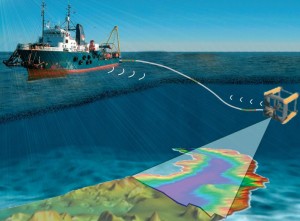By Izhar Ahmad
Operating in isolation and out of sight, the subsea cable industry is the enabler of inter and intra-regional communications, international traffic routing, redundancy protection, and a myriad of other important services for telecommunications service providers. The submarine cable systems have been and, in relation to the current broadband growth, continue to be a critical component of the world’s overall telecommunications capability and capacity. More than ninety-percent of the world’s electronic communication is carried out via subsea fiber-optic cables. This fact sufficiently illustrates the extent of dependency that communications networks have on the subsea industry, and the fragility in cross-border submarine communications that, at best, must be respected and protected.
Advancements in the subsea cable industry have ranged from cable burial innovations, using advanced plowing techniques, to the design of highly advanced, open-access subsea cable networks that comprehensively connect all countries within a given region. The MENA region is witnessing the establishment of such subsea cable networks, currently being led by GBI. Despite these advancements, the challenge of effectively communicating the subsea industry’s issues, relating not only to incentivizing future investments but also to the protection of the subsea cable systems, has reached criticality over the years.
Subsea cables are exposed to both natural and man-made hazards that range from tsunamis, which utterly destroy submarine optical networks, to fishing and ship anchoring, which can damage cables—at times, costing millions of dollars to repair. At a macro-level, however, there are some key policy issues that concern the operational well-being of the submarine cable systems.
Currently, no known laws exist that criminalize willful or accidental damage to the submarine systems in this region. Granted that the ability to achieve such legislative feats may rest greatly upon the adoption of pan-regional, well-coordinated monitoring and penalizing mechanisms; at least, collective efforts can be directed to raise awareness and openly lobby to key stakeholders, including concerned government bodies and the investor consortia, the need to enact such laws.
 Submarine infrastructure is a highly conspicuous target for terrorist attacks, which can categorically wreak havoc on inter-regional communication systems, required by financial, transport, medical, and other sectors. There is thus a need to ensure that existing subsea cable systems are protected around and beyond each regional country’s boundaries. Achieving such protection too would require a pan-regional collaborative and collective approach. Policy frameworks for governing how the subsea cable industry, or the ICT industry, in general, interacts with or is impacted by other industries operating in the seas—including both legalized (fishing) and illegal (maritime piracy)—need to be developed. As a matter of fact, all policy frameworks need to be in line with current information and communication needs, technology convergence, and infrastructure expansion plans of the telecom operators.
Submarine infrastructure is a highly conspicuous target for terrorist attacks, which can categorically wreak havoc on inter-regional communication systems, required by financial, transport, medical, and other sectors. There is thus a need to ensure that existing subsea cable systems are protected around and beyond each regional country’s boundaries. Achieving such protection too would require a pan-regional collaborative and collective approach. Policy frameworks for governing how the subsea cable industry, or the ICT industry, in general, interacts with or is impacted by other industries operating in the seas—including both legalized (fishing) and illegal (maritime piracy)—need to be developed. As a matter of fact, all policy frameworks need to be in line with current information and communication needs, technology convergence, and infrastructure expansion plans of the telecom operators.
Damage to submarine cables is inevitable. However, it is the repair processes that need to be made more robust and streamlined. This entails that all coordination efforts be synchronized, to communicate damage, promptly induce cable repairs, conduct investigation, and adopt standard operating procedures to prevent or mitigate similar occurrences in the future. In this respect, concerned government departments and the submarine cable industry need to work together. Similar to national ICT policy frameworks, policy frameworks for protecting and incentivizing subsea cable systems are of paramount importance, given, for example, the fact that OTTP-induced data traffic is on the rise and terrestrial operators are amidst a self-imposed capacity-expansion spree to deal with high network loads. Their reliance on the subsea industry, ultimately, defines their survivability.
In the context of expansion of modern networks and the resulting impact on the overall ICT ecosystem, it is critical that national policy on submarines cables be developed, engaging all key stakeholders, which no longer are limited to ICT investors and also include submarine high-voltage cable investors. To this effect, industry groups, such as SAMENA Telecommunications Council’s Subsea Working Group (SWG), or other similar focal groups, can help play their roles in projecting critical issues and issuing recommendations to policy-makers and regulators. Such groups can also dramatically improve cross-stakeholder communication; help lobby on policy issues relating to licensing, cable routes, cable laying and repairing, as well as other operational issues; and can help establish best practices for the wide spectrum of subsea infrastructure development activities.
Among the needs that the SAMENA region’s ICT industry has, the need to protect and to expand subsea infrastructure is a top priority. Much is at stake not only for the ICT sector but also the sectors that directly, or even remotely, depend on it for their day-to-day operational success. Clearly, the region’s ICT microcosm has multiple dimensions, with each dimension requiring cooperative and collaborative means to be measured and understood. The subsea infrastructure is one such critical dimension. It holds extraordinary potential for developing public-private partnerships (PPP) on issues relating to conflict resolution, efficient repair alerts and management, and the general protection of the subsea infrastructure.
Well-thought-out ICT and subsea policy frameworks that encourage greater broadband investment, PPP formation, and carry futuristic overtones will matter significantly from now onwards.
The writer is government and external relations director with SAMENA Council and is active in policy and position issues as well as ICT regional market research. He is also an associate editor of Teletimes International. He holds an engineering degree from the Thomas J. Watson School of Engineering & Applied Science.
April 9, 2025







